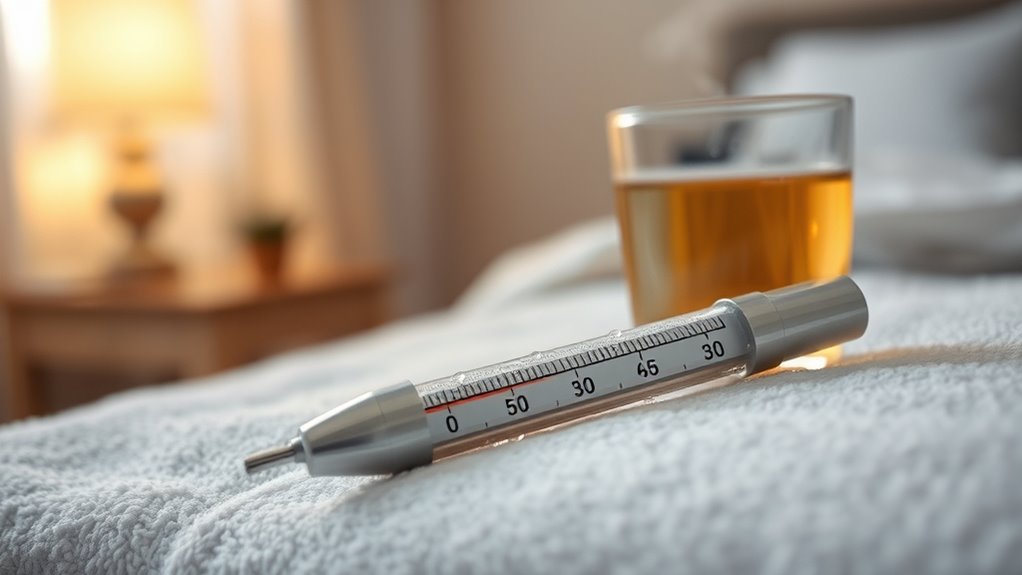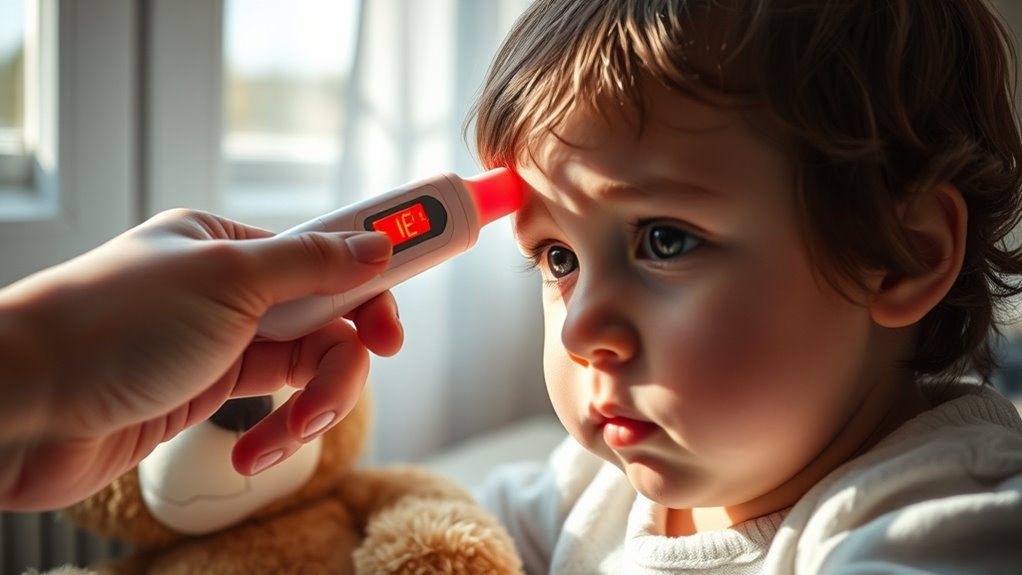When checking for a fever in your child, choose the right method based on their age. For kids under two, use a rectal thermometer for accurate results. If they’re older, you can check orally. Keep them hydrated and allow for plenty of rest. Over-the-counter medications like acetaminophen can help manage their discomfort. Always monitor their temperature closely and seek medical advice if you notice any severe symptoms or if the fever persists. There’s more to know about managing fevers effectively.
Key Takeaways
- Choose the appropriate method to check temperature based on the child’s age: rectal for infants, oral for older children, and axillary for quick checks.
- If using the rectal method, coat the thermometer with petroleum jelly and insert carefully for accurate readings.
- Ensure the child stays hydrated and gets plenty of rest during illness to help manage fever.
- Administer over-the-counter medications like acetaminophen or ibuprofen as needed, following dosage guidelines carefully.
- Seek medical advice immediately for infants under six months old or if the fever persists or worsens.

When your child has a fever, knowing how to check their temperature accurately is essential to understanding their condition. It helps you gauge the severity of their illness and decide if you need to consult a doctor. There are several methods you can use, each suited to different age groups and situations.
The rectal method is the most accurate for children under two years old. To use this method, wash and rinse the thermometer, then coat it with petroleum jelly for easier insertion. Position your child on their back or belly with their knees bent, insert the thermometer about half an inch to an inch, and wait for the beep to get an accurate reading.
The rectal method provides the most accurate temperature reading for children under two years old.
For children over the age of five, the oral method is appropriate. Again, start by washing and rinsing the thermometer. Place it under your child’s tongue, near the back, and have them hold it still until it beeps. This method is reliable, but it works best if your child can cooperate and keep the thermometer in place.
If you need a quick check, especially for younger kids, the axillary method is a good option. Just make sure their underarm is dry, place the thermometer in the armpit with the arm pressed against the body, and wait for it to beep. While this method is less accurate than others, it can give you a quick idea if a fever is present.
The tympanic method offers a quick reading by measuring the temperature inside the ear. Use a clean probe tip, straighten the ear canal, and gently insert the thermometer. This method requires proper technique for accuracy but is often quick and comfortable for children.
Lastly, the temporal artery method scans the forehead, making it an easy option, although it’s less reliable for infants. Content research is essential for ensuring the relevance and quality of health-related information.
If your child has a fever, remember that common causes include colds, flu, ear infections, and bronchitis. Typically, fevers last only two to three days. For babies under six months, seek medical advice immediately.
Keep your child hydrated and ensure they get plenty of rest. Over-the-counter medications like acetaminophen or ibuprofen can help manage fever, but always follow the dosage guidelines. Monitor their temperature regularly and don’t hesitate to seek help if the fever persists or worsens.
Frequently Asked Questions
What Is the Normal Body Temperature Range for Adults?
Normal body temperature for adults ranges from 97°F to 99°F.
You’ll notice it can vary based on factors like age, sex, time of day, and activity level. It’s typically lower in the morning and peaks in the late afternoon.
Remember, each person’s normal temperature might differ, so it’s essential to know your baseline.
When measuring, consider the method you use, as different techniques can yield varying results.
Can Fever Be a Symptom of a Serious Condition?
Yes, fever can definitely be a symptom of a serious condition.
When you experience a fever, it might indicate infections like pneumonia or meningitis, certain cancers, or even autoimmune disorders.
If you have underlying health issues, a fever could worsen those conditions.
It’s important to monitor fever closely, especially if you notice other concerning symptoms, as they may require immediate medical attention.
Always trust your instincts and consult a healthcare professional if unsure.
How Often Should I Check My Temperature During a Fever?
When you’re dealing with a fever, frequent checks are fundamental. You should check your temperature every few hours to monitor any changes.
If your thermometer’s reading rises above 101°F, it’s time to take note. Establishing a baseline by checking twice daily can help you understand your body’s fluctuations.
When Should I Seek Medical Attention for a Fever?
When you’ve got a fever, knowing when to seek medical attention is crucial.
If your infant’s temperature hits 100.4°F or higher, don’t wait—get them to a doctor immediately.
For older kids, look for other symptoms if the fever’s between 102.2°F and 104°F.
Adults should seek help at 103°F.
Always consult a doctor if the fever lasts over three days or worsens, especially if you notice severe symptoms.
Your health matters!
Are There Any Home Remedies to Reduce Fever?
Did you know that staying hydrated can reduce fever duration by up to 33%?
To naturally lower your fever at home, drink plenty of water or electrolyte-rich beverages.
Sponging with cold water or placing a damp washcloth on your forehead can also help.
Consider taking a lukewarm bath and wearing lightweight clothing to aid in cooling.
Eating nutritious foods and resting will support your recovery as well.
Conclusion
In conclusion, knowing how to handle a fever can make a big difference in your comfort and recovery. Did you know that nearly 75% of people experience a fever at some point in their lives? That just shows how common it is! So, whether you’re monitoring your temperature or providing care for someone else, stay calm and follow the steps outlined. Remember, you’re not alone in this—most of us have been there and come out just fine!









